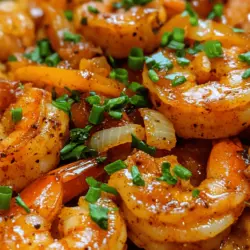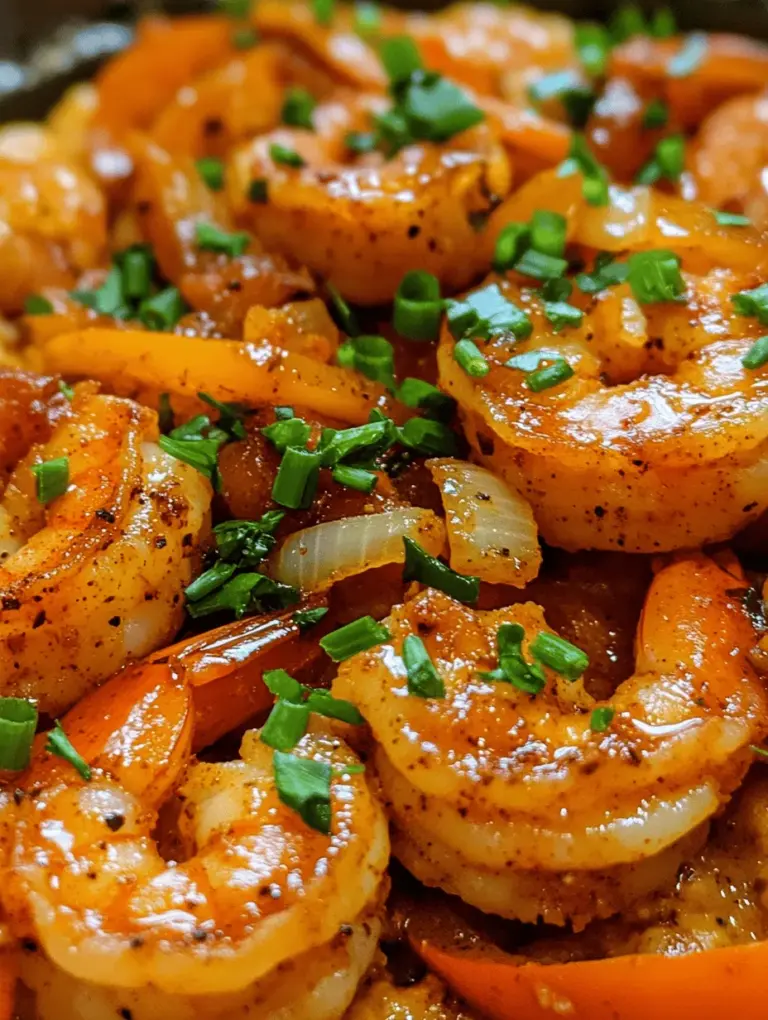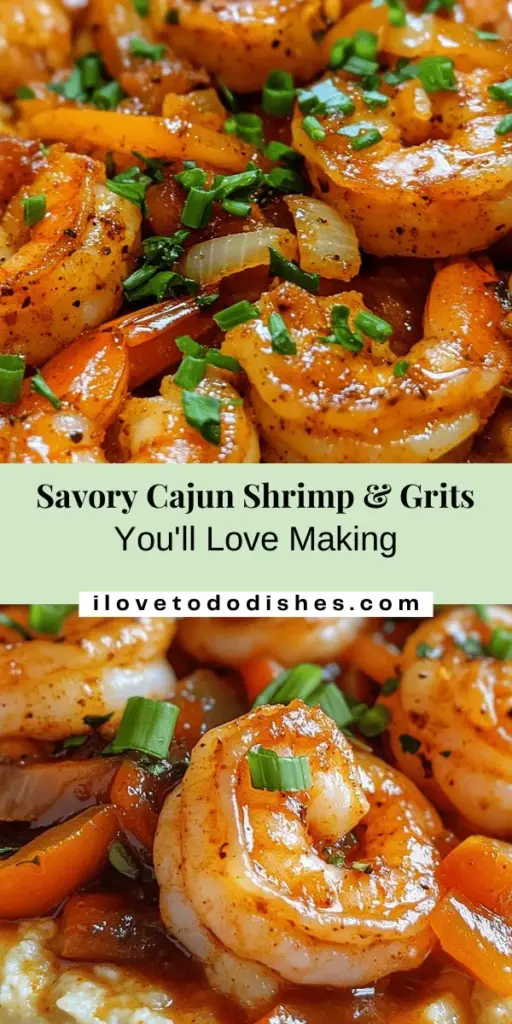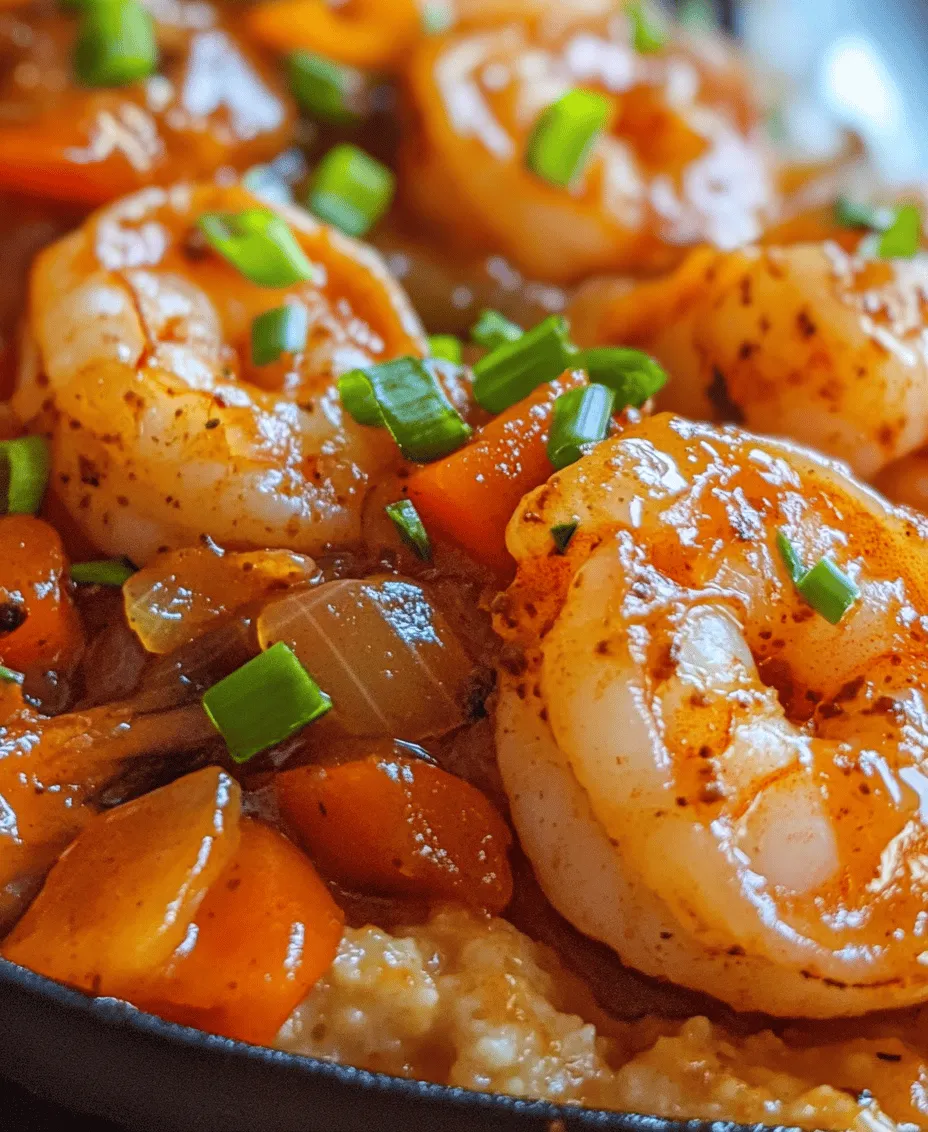Introduction
Cajun Shrimp & Grits is a dish that embodies the vibrant and rich culinary traditions of the Southern United States. Emerging from the Creole cooking styles of Louisiana, this comfort food classic marries the bold, spicy flavors of Cajun cuisine with the creamy, savory goodness of grits. Whether enjoyed as a hearty breakfast, a satisfying brunch, or a delightful dinner, this dish not only captivates the palate but also delights the eyes with its colorful array of ingredients.
At its core, Cajun Shrimp & Grits is a celebration of the region’s heritage, showcasing the bounty of fresh seafood and the robust spices that define Cajun cooking. The combination of succulent shrimp, rich grits, and a medley of aromatic vegetables creates a dish that is both filling and flavorful, making it a favorite among many food enthusiasts. In this comprehensive guide, we will delve into the origins of this iconic dish, explore the essential ingredients and their roles, and provide you with a step-by-step process to create the best Cajun Shrimp & Grits recipe.
The Cultural Significance of Cajun Cuisine
Understanding Cajun Heritage
Cajun culture has its roots in the Acadian people who were expelled from Canada in the 18th century and settled in Louisiana. This unique blend of French, Spanish, African, and Native American influences has created a distinctive culinary identity that is celebrated throughout the southern states. Cajun cuisine, characterized by its bold flavors and use of local ingredients, is deeply intertwined with the culture and traditions of the region.
Seafood plays a pivotal role in Cajun cooking, largely due to the region’s access to the Gulf of Mexico. Shrimp, in particular, is a staple ingredient in many Cajun dishes, reflecting the local fishing practices and the importance of fresh, sustainable seafood. The use of shrimp in dishes like Cajun Shrimp & Grits not only highlights the seafood heritage of the region but also showcases the adaptability and creativity of Cajun cooks who have perfected their recipes over generations.
Historical Influences on Cajun Recipes
The history of Cajun cuisine is marked by adaptation and innovation. As ingredients and cooking techniques evolved through the years, traditional recipes were modified to suit the local palate and available resources. The influence of Spanish and French cooking is evident in the use of techniques such as sautéing, which enhances the flavors of the ingredients, while the African heritage contributes to the rich use of spices and seasonings.
In Cajun cooking, the emphasis on communal meals reflects the culture’s values of family and togetherness. Dishes are often prepared in large quantities, allowing families and friends to gather and enjoy the flavors of their ancestry. This sense of community is an integral part of the dining experience, transforming each meal into a celebration of culture and heritage.
Flavor Profiles in Cajun Cooking
Key Spices and Herbs Used in Cajun Dishes
One of the hallmarks of Cajun cuisine is its bold flavor profile, achieved through the careful use of spices and herbs. Essential spices such as cayenne pepper, paprika, and black pepper create a signature heat, while herbs like thyme, oregano, and parsley add layers of flavor. The use of Cajun seasoning—a blend of these spices—has become a staple in many households, infusing dishes with the characteristic taste of the region.
The balance of heat and flavor is a defining feature of Cajun dishes. Chefs skillfully adjust the level of spiciness to suit the preferences of their diners, ensuring that the dish is not only hot but also flavorful. This approach to seasoning allows for a harmonious blend of ingredients, elevating the overall taste experience.
Ingredients Breakdown
Essential Ingredients for Cajun Shrimp
To create the best Cajun Shrimp & Grits, it’s crucial to understand the key ingredients that come together to form this beloved dish. The star of the show, of course, is the shrimp. When selecting shrimp, opt for fresh or frozen varieties that are sustainably sourced—preferably wild-caught Gulf shrimp, known for their sweet, succulent flavor. Look for shrimp that are firm to the touch and have a clean, briny scent.
Cajun seasoning is another essential component of this dish. A homemade blend typically includes paprika, cayenne pepper, garlic powder, onion powder, and dried herbs. This seasoning not only enhances the shrimp’s flavor but also adds a vibrant color to the dish. The balance of spices in the seasoning is crucial for achieving that authentic Cajun taste.
In addition to shrimp and Cajun seasoning, the role of aromatic vegetables like garlic, bell peppers, and onions cannot be overlooked. These ingredients serve as the flavor base for the dish, infusing it with depth and complexity. Sautéing them until they are tender and fragrant allows their natural sweetness to develop, which beautifully complements the spice of the shrimp.
Understanding Grits
Grits are the creamy, comforting foundation of this dish. Made from ground corn, grits come in various forms, but they are primarily categorized into two types: stone-ground and instant. Stone-ground grits are coarser and require a longer cooking time, resulting in a rich, creamy texture that is well worth the wait. Instant grits, while convenient, often lack the depth of flavor and texture found in their stone-ground counterparts.
Nutritionally, grits are a great source of carbohydrates, providing energy for your day. They also offer a small amount of protein and fiber, especially when made with whole grain corn. To elevate the flavor and creaminess of the grits, many recipes incorporate cheese and cream. Cheddar cheese, in particular, enhances the richness of the dish and pairs well with the spiciness of the shrimp.
Step-by-Step Guide to the Best Cajun Shrimp & Grits
Preparing the Grits
Start by bringing a pot of water or broth to a boil. The liquid you choose will influence the flavor of your grits, so using chicken or vegetable broth can add an extra layer of richness. Once boiling, gradually whisk in the stone-ground grits, ensuring there are no lumps. Reduce the heat to low, cover the pot, and let the grits simmer gently.
Stir the grits occasionally, allowing them to absorb the liquid and become creamy. Depending on the type of grits, this process can take anywhere from 20 to 40 minutes. If you’re using instant grits, follow the package instructions, but opt for broth instead of water for added flavor.
As the grits cook, consider adding a pinch of salt and a pat of butter to enhance the creaminess. Once the grits are tender and have reached your desired consistency, stir in shredded cheddar cheese and a splash of heavy cream for an indulgent finish. Taste and adjust the seasoning as necessary, keeping in mind that the flavors will meld beautifully with the Cajun shrimp.
Now that you have a foundational understanding of the rich culinary traditions behind Cajun Shrimp & Grits and the essential ingredients involved, you’re ready to dive deeper into the cooking process. In the next part of this guide, we will explore how to prepare the shrimp, create the flavorful sauce, and perfectly assemble your dish for a stunning presentation. Stay tuned for the continuation of this mouthwatering journey!
Detailed Instructions on Choosing and Cooking Grits
When it comes to making the perfect Cajun Shrimp & Grits, the quality and type of grits you choose can significantly impact your dish. Here’s how to select and prepare grits for this Southern classic:
1. Choosing Grits:
– Types of Grits: You can choose between stone-ground, quick-cooking, and instant grits. Stone-ground grits are the best option for flavor and texture, but they take longer to cook. Quick-cooking grits save time without sacrificing too much quality. Instant grits are less desirable for this recipe as they can often lead to a mushy texture.
– Flavor: Opt for grits that are labeled as “white” or “yellow” depending on your flavor preference. White grits have a milder taste, while yellow grits lend a nuttier flavor.
2. Cooking Grits:
– Preparation: Start by rinsing the grits under cold water to remove excess starch. This step helps to achieve a creamier consistency.
– Cooking Liquid: Use a combination of water and milk or broth for cooking grits to enhance their flavor. A typical ratio is 4 cups of liquid to 1 cup of grits.
– Cooking Process: Bring your liquid to a boil, then gradually whisk in the grits. Reduce the heat to low, cover, and let them simmer. For stone-ground grits, this can take up to 30-45 minutes. Quick-cooking grits will need about 5-10 minutes.
Tips for Achieving the Perfect Creamy Consistency
For the ultimate creamy grits, follow these tips:
– Stirring: Stir the grits frequently while they cook to prevent clumping and ensure even cooking. This also helps to incorporate air, making them light and fluffy.
– Butter and Cheese: Once the grits are cooked, stir in generous amounts of butter and cheese (cheddar or pepper jack work wonderfully) for a rich, creamy texture. Aim for about 1-2 tablespoons of butter and ½ cup of cheese per cup of dry grits.
– Adjusting Thickness: If your grits are too thick, add a splash of additional milk or broth to achieve your desired consistency.
Cooking the Cajun Shrimp
Now that your grits are ready, let’s dive into preparing the Cajun shrimp.
Seasoning Techniques for Shrimp: Marinating and Seasoning Tips
– Marinating Shrimp: For maximum flavor, marinate your shrimp. Combine olive oil, minced garlic, lemon juice, and Cajun seasoning in a bowl, and toss the shrimp until they are well coated. Allow them to marinate for at least 15-30 minutes.
– Seasoning: If you prefer not to marinate, season the shrimp with Cajun seasoning just before cooking. Use about 1-2 tablespoons per pound of shrimp, adjusting to your heat preference.
Sautéing Vegetables for a Flavor Base
– Vegetables to Use: Start with a mix of diced onion, bell pepper, and celery, which is known as the “holy trinity” in Cajun cooking. You can also add minced garlic for extra flavor.
– Cooking Process: Heat a skillet over medium heat and add a tablespoon of olive oil. Sauté the vegetables until they are soft and translucent, about 5-7 minutes. This creates a flavorful base for your shrimp.
Cooking Shrimp to Perfection: Color Indicators and Timing
– Cooking the Shrimp: Add the marinated shrimp to the skillet with the sautéed vegetables. Cook for 2-3 minutes on each side until the shrimp are pink and opaque. Be careful not to overcook them, as they can become rubbery.
– Color Indicators: The shrimp are done when they turn from translucent to a vibrant pink color.
Combining the Elements
With your grits and shrimp ready, it’s time to bring everything together.
How to Layer Flavors Effectively
– Combining: Once the shrimp are cooked, mix them gently into the grits. This allows the creamy grits to absorb the flavors from the shrimp and vegetables.
– Adjusting Seasoning: Taste and adjust the seasoning if necessary, adding more salt, pepper, or Cajun seasoning to suit your preference.
The Importance of Presentation in Serving Cajun Shrimp & Grits
– Serving Style: Serve the grits in shallow bowls, topped with the shrimp mixture. This not only makes for an appealing presentation but also allows the sauce to pool around the grits.
Ideal Garnishes and Their Flavor Contributions
– Garnishing: Finish with a sprinkle of chopped green onions, parsley, or cilantro for a fresh touch. A few dashes of hot sauce can enhance the dish’s flavor profile and add an extra kick.
Tips for Customization and Variations
Don’t hesitate to make this recipe your own! Here are some ideas for customization:
Personalizing Your Dish
– Ingredient Swaps: For a gluten-free version, ensure your grits are certified gluten-free. If you’re dairy-free, consider using coconut milk or a dairy-free cheese alternative.
– Adding Vegetables: Incorporate spinach or kale for added nutrition and a pop of color.
Spicing It Up: Adjusting Heat Levels for Personal Taste
– Adjusting Heat: If you prefer a milder dish, reduce the amount of Cajun seasoning or substitute with a milder blend. For spice lovers, consider adding diced jalapeños or a hint of cayenne pepper to the shrimp marinade.
Exploring Fusion Recipes
Get creative by exploring variations of Cajun Shrimp & Grits:
– Cajun Shrimp Tacos: Use the shrimp and grits as a filling for soft tortillas topped with avocado and lime crema.
– Shrimp & Grits Pizza: Spread a layer of creamy grits on a pizza crust and top with sautéed shrimp, cheese, and fresh herbs.
Conclusion
Cajun Shrimp & Grits is more than just a dish; it’s a celebration of culture, flavor, and comfort. By mastering this recipe, you not only expand your culinary repertoire but also gain a deeper appreciation for the rich traditions that define Cajun cuisine. Whether served for a casual family dinner or a special occasion, this dish promises to impress with its vibrant flavors and creamy textures. Embrace the experience of cooking and enjoy every bite of this Southern classic. Remember, the journey of crafting this dish is just as rewarding as the final outcome, so take your time, savor the process, and share your culinary creation with loved ones!



